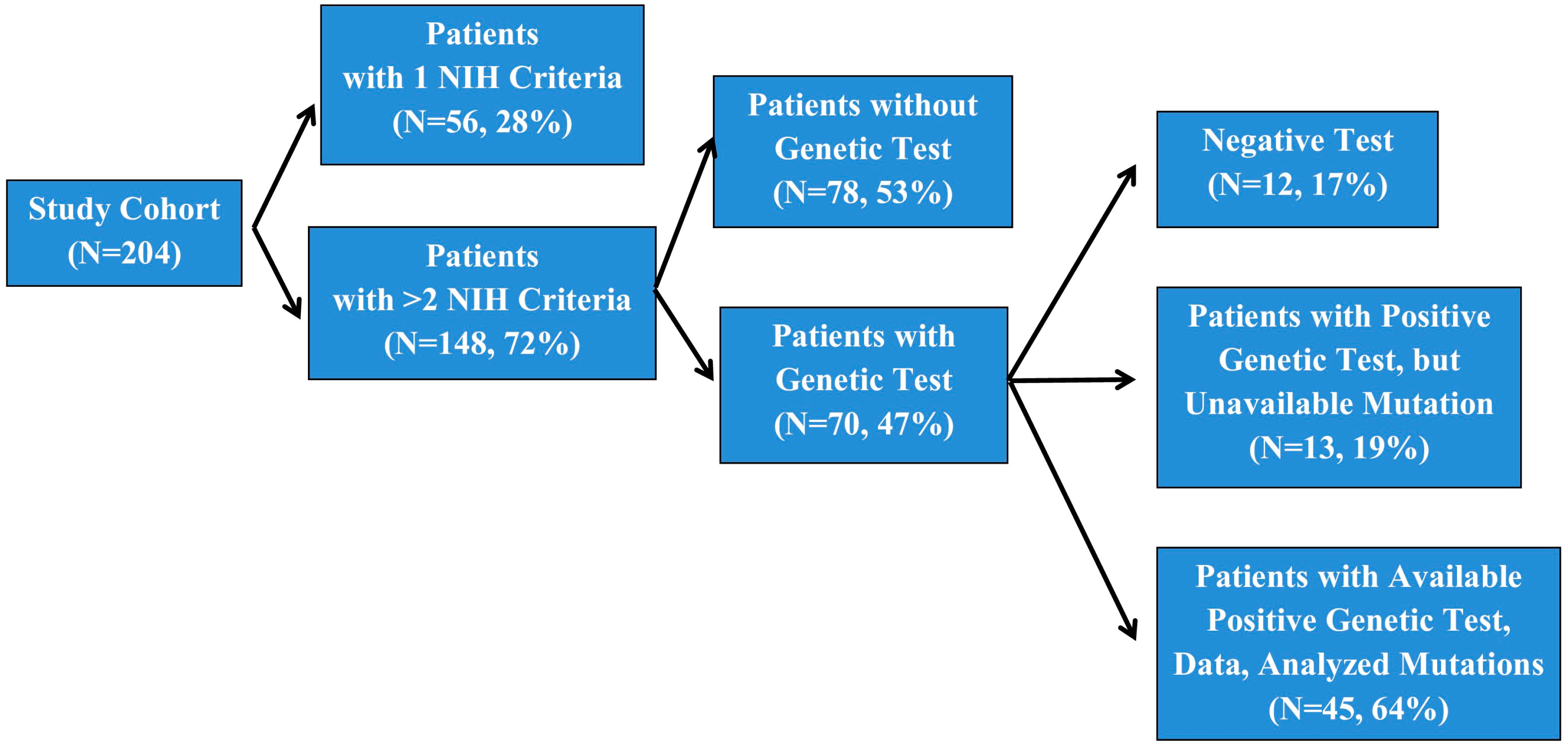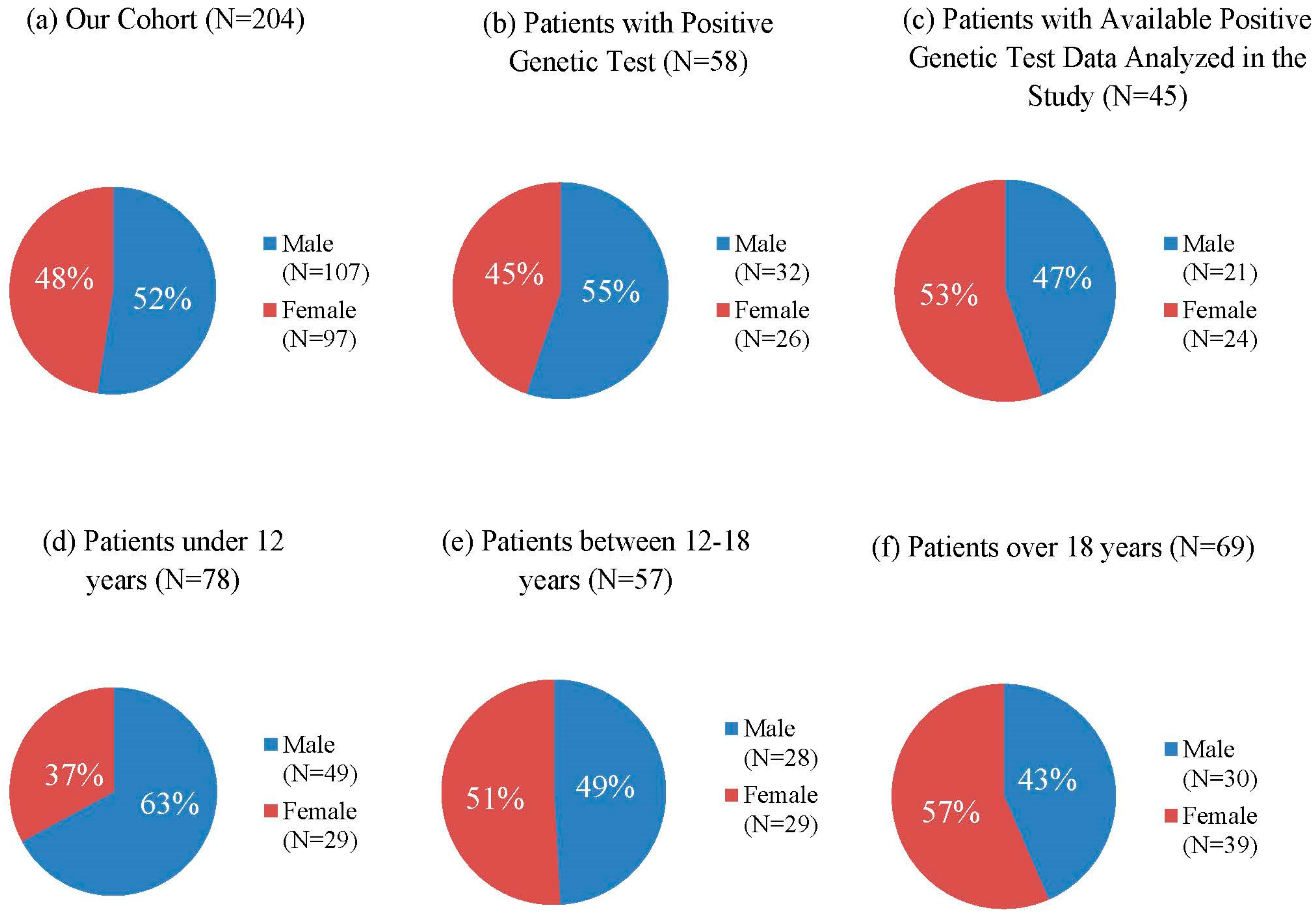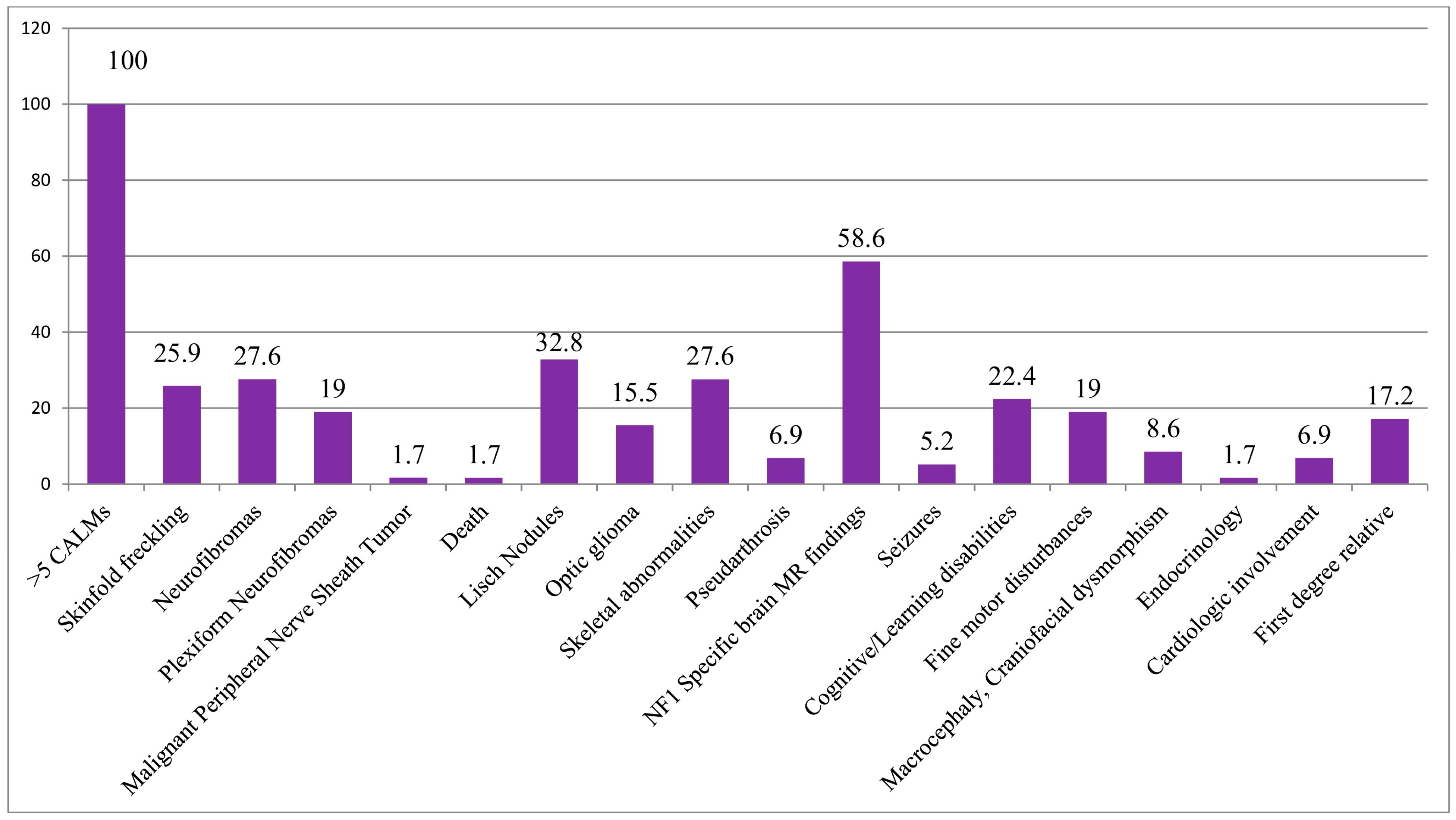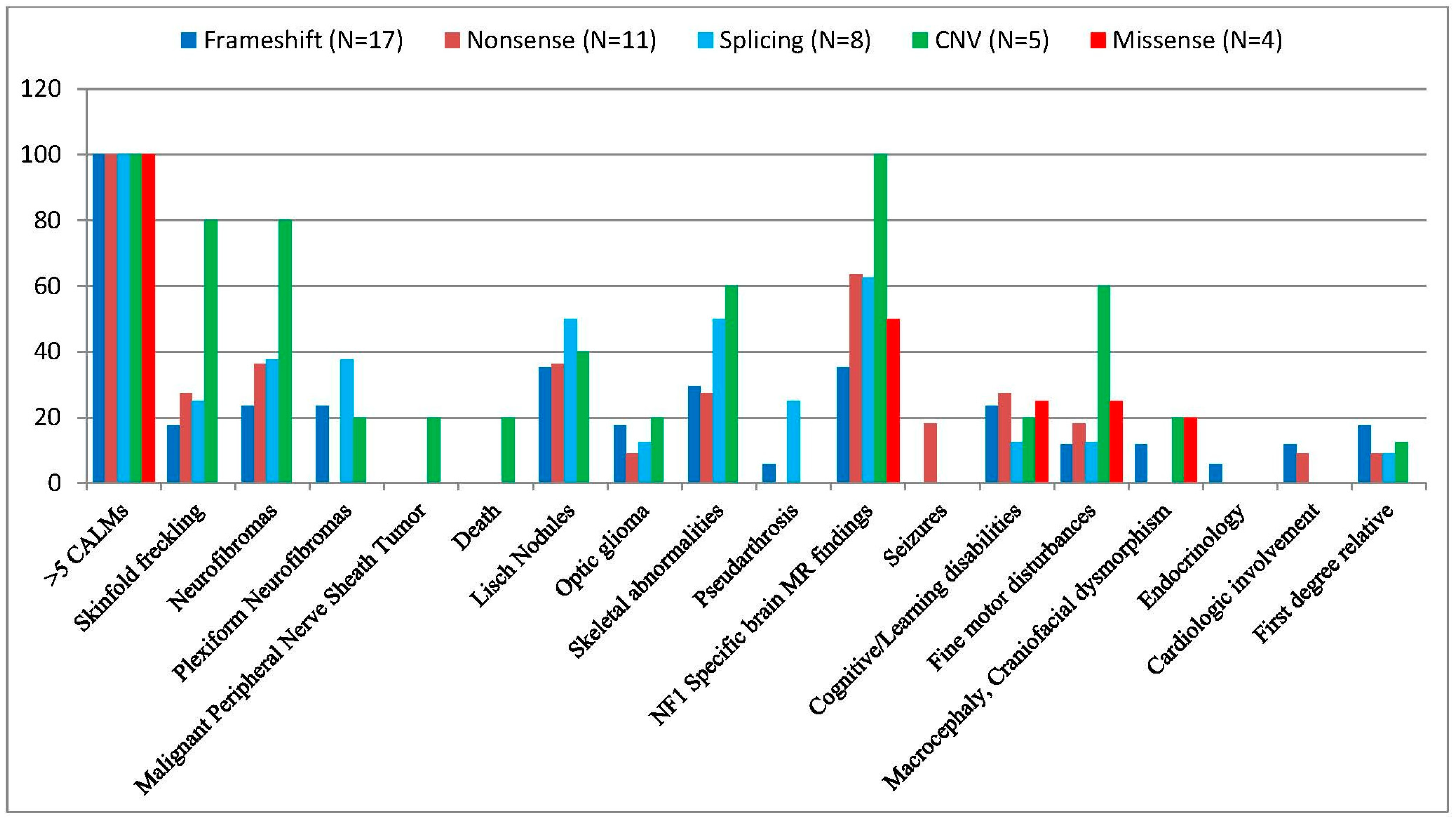Increased Phenotype Severity Associated with Splice-Site Variants in a Hungarian Pediatric Neurofibromatosis 1 Cohort: A Retrospective Study
Abstract
1. Introduction
Clinical Characteristics
2. Materials and Methods
3. Results
4. Discussion
5. Conclusions
Author Contributions
Funding
Institutional Review Board Statement
Informed Consent Statement
Data Availability Statement
Acknowledgments
Conflicts of Interest
References
- Veres, K.; Gál, A.I.; Fodor, A.; Garami, M.; Csóka, M.; Szalai, Z.Z. Terápiás újdonságok a gyermekbőrgyógyászatban. Bőrgyógyászati és Venerológiai Szemle 2023, 99, 342–354. [Google Scholar] [CrossRef]
- Tamura, R. Current Understanding of Neurofibromatosis Type 1, 2, and Schwannomatosis. Int. J. Mol. Sci. 2021, 22, 5850. [Google Scholar] [CrossRef]
- Wilson, B.N.; John, A.M.; Handler, M.Z.; Schwartz, R.A. Neurofibromatosis Type 1: New Developments in Genetics and Treatment. J. Am. Acad. Dermatol. 2021, 84, 1667–1676. [Google Scholar] [CrossRef] [PubMed]
- Ferner, R.E.; Gutmann, D.H. Neurofibromatosis type 1 (NF1): Diagnosis and management. Handb. Clin. Neurol. 2013, 115, 939–955. [Google Scholar] [CrossRef] [PubMed]
- Büki, G.; Bekő, A.; Bödör, C.; Urbán, P.; Németh, K.; Hadzsiev, K.; Fekete, G.; Kehrer-Sawatzki, H.; Bene, J. Identification of an NF1 Microdeletion with Optical Genome Mapping. Int. J. Mol. Sci. 2023, 24, 13580. [Google Scholar] [CrossRef]
- Bettegowda, C.; Upadhayaya, M.; Evans, D.G.; Kim, A.; Mathios, D.; Hanemann, C.O. Genotype-Phenotype Correlations in Neurofibromatosis and Their Potential Clinical Use. Neurology 2021, 97, S91–S98. [Google Scholar] [CrossRef] [PubMed]
- Alkindy, A.; Chuzhanova, N.; Kini, U.; Cooper, D.N.; Upadhyaya, M. Genotype-Phenotype Associations in Neurofibromatosis Type 1 (NF1): An Increased Risk of Tumor Complications in Patients with NF1 Splice-Site Mutations? Hum. Genomics 2012, 6, 12. [Google Scholar] [CrossRef] [PubMed]
- Pálla, S.; Lőrincz, K.; Bánvölgyi, A.; Medvecz, M. Dermatologic aspects of NF1: Revised diagnostic criteria and new therapeutic modalities. Bőrgyógyászati és Venerológiai Szemle 2022, 98, 88–96. [Google Scholar] [CrossRef]
- Legius, E.; Messiaen, L.; Wolkenstein, P.; Pancza, P.; Avery, R.A.; Berman, Y.; Blakeley, J.; Babovic-Vuksanovic, D.; Cunha, K.S.; Ferner, R.; et al. Revised Diagnostic Criteria for Neurofibromatosis Type 1 and Legius Syndrome: An International Consensus Recommendation. Genet. Med. 2021, 23, 1506. [Google Scholar] [CrossRef]
- Pálla, S.; Anker, P.; Farkas, K.; Plázár, D.; Kiss, S.; Marschalkó, P.; Szalai, Z.; Bene, J.; Hadzsiev, K.; Maróti, Z.; et al. Co-Occurrence of Neurofibromatosis Type 1 and Pseudoachondroplasia—A First Case Report. BMC Pediatr. 2023, 23, 110. [Google Scholar] [CrossRef] [PubMed]
- Nasi, L.; Alexopoulos, A.; Kokkinou, E.; Roka, K.; Tzetis, M.; Tsipi, M.; Kakourou, T.; Kanaka-Gantenbein, C.; Chrousos, G.; Kattamis, A.; et al. Characteristics of Café-au-lait Macules and their Association with the Neurofibromatosis type I Genotype in a Cohort of Greek Children. Acta Derm. Venereol. 2023, 103, 5758. [Google Scholar] [CrossRef] [PubMed]
- García-Martínez, F.J.; Duat-Rodríguez, A.; Andrés Esteban, E.; Torrelo, A.; Noguera Morel, L.; Hernández-Martín, A. Cutaneous Manifestations not Considered Diagnostic Criteria for Neurofibromatosis Type 1. A Case-Control Study. Actas Dermosifiliogr. 2022, 113, 923–929. [Google Scholar] [CrossRef]
- Vázquez-Osorio, I.; Duat-Rodríguez, A.; García-Martínez, F.J.; Torrelo, A.; Noguera-Morel, L.; Hernández-Martín, A. Cutaneous and Systemic Findings in Mosaic Neurofibromatosis Type 1. Pediatr. Dermatol. 2017, 34, 271–276. [Google Scholar] [CrossRef] [PubMed]
- Mulinda, C.; Yun, S.; Fenner, J.; Garzon, M.C.; Scollan, M.E.; Levin, L.E. How Many Is Too Many? A Review of the Significant Numbers in Pediatric Skin Lesions and Their Recommended Evaluation. Pediatr. Dermatol. 2024, 41, 1021–1029. [Google Scholar] [CrossRef] [PubMed]
- Pinna, V.; Lanari, V.; Daniele, P.; Consoli, F.; Agolini, E.; Margiotti, K.; Bottillo, I.; Torrente, I.; Bruselles, A.; Fusilli, C.; et al. P.Arg1809Cys Substitution in Neurofibromin Is Associated with a Distinctive NF1 Phenotype without Neurofibromas. Eur. J. Hum. Genet. EJHG 2015, 23, 1068–1071. [Google Scholar] [CrossRef] [PubMed]
- Gross, A.M.; Wolters, P.L.; Dombi, E.; Baldwin, A.; Whitcomb, P.; Fisher, M.J.; Weiss, B.; Kim, A.; Bornhorst, M.; Shah, A.C.; et al. Selumetinib in Children with Inoperable Plexiform Neurofibromas. N. Engl. J. Med. 2020, 382, 1430–1442. [Google Scholar] [CrossRef] [PubMed]
- Pearson, A.D.; Allen, C.; Fangusaro, J.; Hutter, C.; Witt, O.; Weiner, S.; Reaman, G.; Russo, M.; Bandopadhayay, P.; Ahsan, S.; et al. Paediatric Strategy Forum for Medicinal Product Development in Mitogen-Activated Protein Kinase Pathway Inhibitors: ACCELERATE in Collaboration with the European Medicines Agency with Participation of the Food and Drug Administration. Eur. J. Cancer Oxf. Engl. 2022, 177, 120–142. [Google Scholar] [CrossRef]
- Armstrong, A.E.; Belzberg, A.J.; Crawford, J.R.; Hirbe, A.C.; Wang, Z.J. Treatment Decisions and the Use of MEK Inhibitors for Children with Neurofibromatosis Type 1-Related Plexiform Neurofibromas. BMC Cancer 2023, 23, 553. [Google Scholar] [CrossRef] [PubMed]
- Staedtke, V.; Anstett, K.; Bedwell, D.; Giovannini, M.; Keeling, K.; Kesterson, R.; Kim, Y.; Korf, B.; Leier, A.; McManus, M.L.; et al. Gene-Targeted Therapy for Neurofibromatosis and Schwannomatosis: The Path to Clinical Trials. Clin. Trials 2024, 21, 51–66. [Google Scholar] [CrossRef] [PubMed]
- Ly, K.I.; Blakeley, J.O. The Diagnosis and Management of Neurofibromatosis Type 1. Med. Clin. N. Am. 2019, 103, 1035–1054. [Google Scholar] [CrossRef]
- Lalor, L.; Davies, O.M.T.; Basel, D.; Siegel, D.H. Café Au Lait Spots: When and How to Pursue Their Genetic Origins. Clin. Dermatol. 2020, 38, 421–431. [Google Scholar] [CrossRef] [PubMed]
- Hamm, H.; Emmerich, K.; Olk, J. Pigmented macules as possible early signs of genetic syndromes. Hautarzt 2019, 70, 506–513. [Google Scholar] [CrossRef] [PubMed]
- Ben-Shachar, S.; Dubov, T.; Toledano-Alhadef, H.; Mashiah, J.; Sprecher, E.; Constantini, S.; Leshno, M.; Messiaen, L.M. Predicting Neurofibromatosis Type 1 Risk among Children with Isolated Café-Au-Lait Macules. J. Am. Acad. Dermatol. 2017, 76, 1077–1083.e3. [Google Scholar] [CrossRef] [PubMed]
- Wang, W.; Wei, C.-J.; Cui, X.-W.; Li, Y.-H.; Gu, Y.-H.; Gu, B.; Li, Q.-F.; Wang, Z.-C. Impacts of NF1 Gene Mutations and Genetic Modifiers in Neurofibromatosis Type 1. Front. Neurol. 2021, 12, 704639. [Google Scholar] [CrossRef] [PubMed]
- Ozarslan, B.; Russo, T.; Argenziano, G.; Santoro, C.; Piccolo, V. Cutaneous Findings in Neurofibromatosis Type 1. Cancers 2021, 13, 463. [Google Scholar] [CrossRef]
- Albaghdadi, M.; Thibodeau, M.L.; Lara-Corrales, I. Updated Approach to Patients with Multiple Café au Lait Macules. Dermatol. Clin. 2022, 40, 9–23. [Google Scholar] [CrossRef] [PubMed]
- Jouhilahti, E.-M.; Peltonen, S.; Callens, T.; Jokinen, E.; Heape, A.M.; Messiaen, L.; Peltonen, J. The Development of Cutaneous Neurofibromas. Am. J. Pathol. 2011, 178, 500–505. [Google Scholar] [CrossRef] [PubMed]
- Ortonne, N.; Wolkenstein, P.; Blakeley, J.O.; Korf, B.; Plotkin, S.R.; Riccardi, V.M.; Miller, D.C.; Huson, S.; Peltonen, J.; Rosenberg, A.; et al. Cutaneous Neurofibromas: Current Clinical and Pathologic Issues. Neurology 2018, 91, S5–S13. [Google Scholar] [CrossRef]
- Chen, Z.; Mo, J.; Brosseau, J.-P.; Shipman, T.; Wang, Y.; Liao, C.-P.; Cooper, J.M.; Allaway, R.J.; Gosline, S.J.C.; Guinney, J.; et al. Spatiotemporal Loss of NF1 in Schwann Cell Lineage Leads to Different Types of Cutaneous Neurofibroma Susceptible to Modification by the Hippo Pathway. Cancer Discov. 2019, 9, 114–129. [Google Scholar] [CrossRef] [PubMed]
- Gross, A.M.; Singh, G.; Akshintala, S.; Baldwin, A.; Dombi, E.; Ukwuani, S.; Goodwin, A.; Liewehr, D.J.; Steinberg, S.M.; Widemann, B.C. Association of Plexiform Neurofibroma Volume Changes and Development of Clinical Morbidities in Neurofibromatosis 1. Neuro-Oncol. 2018, 20, 1643–1651. [Google Scholar] [CrossRef] [PubMed]
- Corsello, G.; Antona, V.; Serra, G.; Zara, F.; Giambrone, C.; Lagalla, L.; Piccione, M.; Piro, E. Clinical and Molecular Characterization of 112 Single-Center Patients with Neurofibromatosis Type 1. Ital. J. Pediatr. 2018, 44, 45. [Google Scholar] [CrossRef]
- Kehrer-Sawatzki, H.; Mautner, V.-F.; Cooper, D.N. Emerging Genotype-Phenotype Relationships in Patients with Large NF1 Deletions. Hum. Genet. 2017, 136, 349–376. [Google Scholar] [CrossRef] [PubMed]
- Maharaj, A.; Singh, V.; Lalchan, S. Lisch and the Importance of His Nodules. West Indian Med. J. 2014, 63, 799–802. [Google Scholar] [CrossRef][Green Version]
- Stella, A.; Lastella, P.; Loconte, D.C.; Bukvic, N.; Varvara, D.; Patruno, M.; Bagnulo, R.; Lovaglio, R.; Bartolomeo, N.; Serio, G.; et al. Accurate Classification of NF1 Gene Variants in 84 Italian Patients with Neurofibromatosis Type 1. Genes 2018, 9, 216. [Google Scholar] [CrossRef] [PubMed]
- Sabbagh, A.; Pasmant, E.; Imbard, A.; Luscan, A.; Soares, M.; Blanché, H.; Laurendeau, I.; Ferkal, S.; Vidaud, M.; Pinson, S.; et al. NF1 Molecular Characterization and Neurofibromatosis Type I Genotype-Phenotype Correlation: The French Experience. Hum. Mutat. 2013, 34, 1510–1518. [Google Scholar] [CrossRef] [PubMed]
- Castle, B.; Baser, M.E.; Huson, S.M.; Cooper, D.N.; Upadhyaya, M. Evaluation of Genotype-Phenotype Correlations in Neurofibromatosis Type 1. J. Med. Genet. 2003, 40, e109. [Google Scholar] [CrossRef]
- Campen, C.J.; Gutmann, D.H. Optic Pathway Gliomas in Neurofibromatosis Type 1. J. Child Neurol. 2018, 33, 73–81. [Google Scholar] [CrossRef] [PubMed]
- Tabata, M.M.; Li, S.; Knight, P.; Bakker, A.; Sarin, K.Y. Phenotypic Heterogeneity of Neurofibromatosis Type 1 in a Large International Registry. JCI Insight 2020, 5, e136262. [Google Scholar] [CrossRef]
- Delucia, T.A.; Yohay, K.; Widmann, R.F. Orthopaedic Aspects of Neurofibromatosis: Update. Curr. Opin. Pediatr. 2011, 23, 46–52. [Google Scholar] [CrossRef]
- Elefteriou, F.; Kolanczyk, M.; Schindeler, A.; Viskochil, D.H.; Hock, J.M.; Schorry, E.K.; Crawford, A.H.; Friedman, J.M.; Little, D.; Peltonen, J.; et al. Skeletal Abnormalities in Neurofibromatosis Type 1: Approaches to Therapeutic Options. Am. J. Med. Genet. A 2009, 149A, 2327–2338. [Google Scholar] [CrossRef]
- Năstase, F.; Radaschin, D.S.; Niculeț, E.; Brădeanu, A.V.; Verenca, M.C.; Nechita, A.; Chioncel, V.; Nwabudike, L.C.; Baroiu, L.; Drima Polea, E.; et al. Orthopaedic Manifestations of Neurofibromatosis Type 1: A Case Report. Exp. Ther. Med. 2022, 23, 135. [Google Scholar] [CrossRef] [PubMed]
- Sánchez Marco, S.B.; López Pisón, J.; Calvo Escribano, C.; González Viejo, I.; Miramar Gallart, M.D.; Samper Villagrasa, P. Neurological Manifestations of Neurofibromatosis Type 1: Our Experience. Neurologia 2022, 37, 325–333. [Google Scholar] [CrossRef] [PubMed]
- Isenberg, J.C.; Templer, A.; Gao, F.; Titus, J.B.; Gutmann, D.H. Attention Skills in Children with Neurofibromatosis Type 1. J. Child Neurol. 2013, 28, 45–49. [Google Scholar] [CrossRef] [PubMed]
- Kang, E.; Kim, Y.-M.; Choi, Y.; Lee, Y.; Kim, J.; Choi, I.H.; Yoo, H.-W.; Yoon, H.M.; Lee, B.H. Whole-Body MRI Evaluation in Neurofibromatosis Type 1 Patients Younger than 3 Years Old and the Genetic Contribution to Disease Progression. Orphanet J. Rare Dis. 2022, 17, 24. [Google Scholar] [CrossRef] [PubMed]
- Scala, M.; Schiavetti, I.; Madia, F.; Chelleri, C.; Piccolo, G.; Accogli, A.; Riva, A.; Salpietro, V.; Bocciardi, R.; Morcaldi, G.; et al. Genotype-Phenotype Correlations in Neurofibromatosis Type 1: A Single-Center Cohort Study. Cancers 2021, 13, 1879. [Google Scholar] [CrossRef] [PubMed]
- Zhang, J.; Tong, H.; Fu, X.; Zhang, Y.; Liu, J.; Cheng, R.; Liang, J.; Peng, J.; Sun, Z.; Liu, H.; et al. Molecular Characterization of NF1 and Neurofibromatosis Type 1 Genotype-Phenotype Correlations in a Chinese Population. Sci. Rep. 2015, 5, 11291. [Google Scholar] [CrossRef]
- Domon-Archambault, V.; Gagnon, L.; Benoît, A.; Perreault, S. Psychosocial Features of Neurofibromatosis Type 1 in Children and Adolescents. J. Child Neurol. 2018, 33, 225–232. [Google Scholar] [CrossRef]
- Koczkowska, M.; Callens, T.; Gomes, A.; Sharp, A.; Chen, Y.; Hicks, A.D.; Aylsworth, A.S.; Azizi, A.A.; Basel, D.G.; Bellus, G.; et al. Expanding the Clinical Phenotype of Individuals with a 3-Bp in-Frame Deletion of the NF1 Gene (c.2970_2972del): An Update of Genotype–Phenotype Correlation. Genet. Med. 2019, 21, 867–876. [Google Scholar] [CrossRef]
- Carvalho, A.A.; Ferraz, L.D.A.; Martelli, D.R.B.; Machado, R.A.; Martelli, H. Craniofacial Findings in Syndromes Associated with Cafe-Au-Lait Spots: A Literature Review. Rev. Assoc. Médica Bras. 2023, 69, 195–202. [Google Scholar] [CrossRef] [PubMed]
- Ekvall, S.; Sjörs, K.; Jonzon, A.; Vihinen, M.; Annerén, G.; Bondeson, M.-L. Novel Association of Neurofibromatosis Type 1-Causing Mutations in Families with Neurofibromatosis-Noonan Syndrome. Am. J. Med. Genet. A 2014, 164A, 579–587. [Google Scholar] [CrossRef] [PubMed]
- Ece Solmaz, A.; Isik, E.; Atik, T.; Ozkinay, F.; Onay, H. Mutation Spectrum of the NF1 Gene and Genotype-Phenotype Correlations in Turkish Patients: Seventeen Novel Pathogenic Variants. Clin. Neurol. Neurosurg. 2021, 208, 106884. [Google Scholar] [CrossRef] [PubMed]
- Giugliano, T.; Santoro, C.; Torella, A.; Del Vecchio Blanco, F.; Grandone, A.; Onore, M.E.; Melone, M.A.B.; Straccia, G.; Melis, D.; Piccolo, V.; et al. Clinical and Genetic Findings in Children with Neurofibromatosis Type 1, Legius Syndrome, and Other Related Neurocutaneous Disorders. Genes 2019, 10, 580. [Google Scholar] [CrossRef]
- van Minkelen, R.; van Bever, Y.; Kromosoeto, J.N.R.; Withagen-Hermans, C.J.; Nieuwlaat, A.; Halley, D.J.J.; van den Ouweland, A.M.W. A Clinical and Genetic Overview of 18 Years Neurofibromatosis Type 1 Molecular Diagnostics in The Netherlands. Clin. Genet. 2014, 85, 318–327. [Google Scholar] [CrossRef] [PubMed]
- Bianchessi, D.; Morosini, S.; Saletti, V.; Ibba, M.C.; Natacci, F.; Esposito, S.; Cesaretti, C.; Riva, D.; Finocchiaro, G.; Eoli, M. 126 Novel Mutations in Italian Patients with Neurofibromatosis Type 1. Mol. Genet. Genomic Med. 2015, 3, 513–525. [Google Scholar] [CrossRef]
- De Luca, A.; Bottillo, I.; Dasdia, M.C.; Morella, A.; Lanari, V.; Bernardini, L.; Divona, L.; Giustini, S.; Sinibaldi, L.; Novelli, A.; et al. Deletions of NF1 Gene and Exons Detected by Multiplex Ligation-dependent Probe Amplification. J. Med. Genet. 2007, 44, 800–808. [Google Scholar] [CrossRef] [PubMed][Green Version]
- Büki, G.; Zsigmond, A.; Czakó, M.; Szalai, R.; Antal, G.; Farkas, V.; Fekete, G.; Nagy, D.; Széll, M.; Tihanyi, M.; et al. Genotype-Phenotype Associations in Patients With Type-1, Type-2, and Atypical NF1 Microdeletions. Front. Genet. 2021, 12, 673025. [Google Scholar] [CrossRef] [PubMed]
- Kehrer-Sawatzki, H.; Kluwe, L.; Salamon, J.; Well, L.; Farschtschi, S.; Rosenbaum, T.; Mautner, V.-F. Clinical Characterization of Children and Adolescents with NF1 Microdeletions. Childs Nerv. Syst. 2020, 36, 2297. [Google Scholar] [CrossRef]
- Calì, F.; Chiavetta, V.; Ruggeri, G.; Piccione, M.; Selicorni, A.; Palazzo, D.; Bonsignore, M.; Cereda, A.; Elia, M.; Failla, P.; et al. Mutation Spectrum of NF1 Gene in Italian Patients with Neurofibromatosis Type 1 Using Ion Torrent PGMTM Platform. Eur. J. Med. Genet. 2017, 60, 93–99. [Google Scholar] [CrossRef] [PubMed]
- Yang, Y.M.; Yan, K.; Liu, B.; Chen, M.; Wang, L.Y.; Huang, Y.Z.; Qian, Y.Q.; Sun, Y.X.; Li, H.G.; Dong, M.Y. Comprehensive genetic diagnosis of patients with Duchenne/Becker muscular dystrophy (DMD/BMD) and pathogenicity analysis of splice site variants in the DMD gene. J. Zhejiang Univ. Sci. B 2019, 20, 753–765. [Google Scholar] [CrossRef] [PubMed]
- Trevisson, E.; Morbidoni, V.; Forzan, M.; Daolio, C.; Fumini, V.; Parrozzani, R.; Cassina, M.; Midena, E.; Salviati, L.; Clementi, M. The Arg1038Gly Missense Variant in the NF1 Gene Causes a Mild Phenotype without Neurofibromas. Mol. Genet. Genomic Med. 2019, 7, e616. [Google Scholar] [CrossRef] [PubMed]
- Koczkowska, M.; Callens, T.; Chen, Y.; Gomes, A.; Hicks, A.D.; Sharp, A.; Johns, E.; Uhas, K.A.; Armstrong, L.; Bosanko, K.A.; et al. Clinical Spectrum of Individuals with Pathogenic NF1 Missense Variants Affecting p.Met1149, p.Arg1276, and p.Lys1423: Genotype–Phenotype Study in Neurofibromatosis Type 1. Hum. Mutat. 2020, 41, 299–315. [Google Scholar] [CrossRef] [PubMed]
- Zhu, B.; Wang, W.; Gu, Y.; Wei, C.; Wang, Z.; Li, Q. Genotype–Phenotype Correlations and Treatment Innovation of Neurofibromatosis Type 1 (NF1): Current Understanding and Perspective. Chin. Med. J. 2024, 137, 1639–1641. [Google Scholar] [CrossRef] [PubMed]
- Pacot, L.; Vidaud, D.; Sabbagh, A.; Laurendeau, I.; Briand-Suleau, A.; Coustier, A.; Maillard, T.; Barbance, C.; Morice-Picard, F.; Sigaudy, S.; et al. Severe Phenotype in Patients with Large Deletions of NF1. Cancers 2021, 13, 2963. [Google Scholar] [CrossRef]
- Well, L.; Döbel, K.; Kluwe, L.; Bannas, P.; Farschtschi, S.; Adam, G.; Mautner, V.-F.; Salamon, J. Genotype-Phenotype Correlation in Neurofibromatosis Type-1: NF1 Whole Gene Deletions Lead to High Tumor-Burden and Increased Tumor-Growth. PLoS Genet. 2021, 17, e1009517. [Google Scholar] [CrossRef]
- Lorenzo, J.; Barton, B.; Acosta, M.T.; North, K. Mental, Motor, and Language Development of Toddlers with Neurofibromatosis Type 1. J. Pediatr. 2011, 158, 660–665. [Google Scholar] [CrossRef] [PubMed]
- Pardej, S.K.; Glad, D.M.; Casnar, C.L.; Janke, K.M.; Klein-Tasman, B.P. Longitudinal Investigation of Early Motor Development in Neurofibromatosis Type 1. J. Pediatr. Psychol. 2021, 47, 180–188. [Google Scholar] [CrossRef]
- Mautner, V.-F.; Kluwe, L.; Friedrich, R.E.; Roehl, A.C.; Bammert, S.; Högel, J.; Spöri, H.; Cooper, D.N.; Kehrer-Sawatzki, H. Clinical Characterisation of 29 Neurofibromatosis Type-1 Patients with Molecularly Ascertained 1.4 Mb Type-1 NF1 Deletions. J. Med. Genet. 2010, 47, 623–630. [Google Scholar] [CrossRef]
- Mensink, K.A.; Ketterling, R.P.; Flynn, H.C.; Knudson, R.A.; Lindor, N.M.; Heese, B.A.; Spinner, R.J.; Babovic-Vuksanovic, D. Connective Tissue Dysplasia in Five New Patients with NF1 Microdeletions: Further Expansion of Phenotype and Review of the Literature. J. Med. Genet. 2006, 43, e8. [Google Scholar] [CrossRef]
- North, K. Neurofibromatosis Type 1: Review of the First 200 Patients in an Australian Clinic. J. Child Neurol. 1993, 8, 395–402. [Google Scholar] [CrossRef]
- Morris, S.M.; Monroe, C.L.; Gutmann, D.H. Macrocephaly Is Not a Predictor of Optic Pathway Glioma Development or Treatment in Neurofibromatosis Type 1. J. Child Neurol. 2016, 31, 1540–1545. [Google Scholar] [CrossRef]





| NF1 Features | All Positive Genetic Test Results (N = 58) | Under 12 Years (N = 28) | 12–18 Years (N = 20) | Over 18 Years (N = 10) |
|---|---|---|---|---|
| Subjects with positive genetic test | 58 (100%) | 28 (100%) | 20 (100%) | 10 (100%) |
| Male:female | 32:26 (55.2%:44.8%) | 18:10 (64.3%:35.7%) | 10:10 (50%:50%) | 4:6 (40%:60%) |
| >5 CALMs | 58 (100%) | 28 (100%) | 20 (100%) | 10 (100%) |
| Skinfold freckling | 15 (25.9%) | 7 (25%) | 3 (15%) | 5 (50%) |
| Neurofíbromas | 16 (27.6%) | 7 (25%) | 8 (40%) | 1 (10%) |
| Plexiform neurofibromas | 11 (19%) | 5 (17.9%) | 5 (25%) | 1 (10%) |
| Malignant peripheral nerve sheath tumor | 1 (1.7%) | 0 (0%) | 0 (0%) | 1 (10%) |
| Death | 1 (1.7%) | 0 (0%) | 0 (0%) | 1 (10%) |
| Lisch nodules | 19 (32.8%) | 6 (21.4%) | 7 (35%) | 6 (60%) |
| Optic glioma | 9 (15.5%) | 2 (7.1%) | 5 (25%) | 2 (20%) |
| Skeletal abnormalities | 16 (27.6%) | 4 (14.3%) | 9 (45%) | 3 (30%) |
| Pseudarthrosis | 4 (6.9%) | 1 (3.6%) | 2 (10%) | 1 (10%) |
| NF1 specific brain MR findings | 34 (58.6%) | 17 (60.7%) | 12 (60%) | 5 (50%) |
| Seizures | 3 (5.2%) | 0 (0%) | 1 (5%) | 2 (20%) |
| Cognitive/learning disabilities, behavioural disturbances | 13 (22.4%) | 4 (14.3%) | 5 (25%) | 4 (40%) |
| Fine motor disturbances, motor developmental delay | 11 (19%) | 5 (17.9%) | 5 (25%) | 1 (10%) |
| Macrocephaly, craniofacial dysmorphism | 5 (8.6%) | 4 (14.3%) | 0 (0%) | 1 (10%) |
| Endocrinology | 1 (1.7%) | 0 (0%) | 0 (0%) | 1 (10%) |
| Cardiologic Involvement | 4 (6.9%) | 2 (7.1%) | 2 (10%) | 0 (0%) |
| First degree relative | 6 (10.3%) | 3 (10.7%) | 3 (15%) | 0 (0%) |
| NF 1 Features | Mutation-Positive Individuals (N = 58) | Available, Analysed Mutations (N = 45) | Frameshift (N = 17) | Nonsense (N = 11) | Splicing (N = 8) | CNV (N = 5) | Missense (N = 4) |
|---|---|---|---|---|---|---|---|
| Male:female | 32:26 (55.2%:44.8%) | 21:24 (46.7%:53.3%) | 8:7 (53.3%:6.7%) | 4:7 (36.4%:63.6%) | 4:4 (50%:50%) | 1:4 (20%:80%) | 3:1 (75%:25%) |
| >5 CALMs | 58 (100%) | 45 (100%) | 17 (100%) | 11 (100%) | 8 (100%) | 5 (100%) | 4 (100%) |
| Skinfold freckling | 15 (25.9%) | 12 (26.7%) | 3 (17.6%) | 3 (27.3%) | 2 (25%) | 4 (80%) | 0 (0%) |
| Neurofibromas | 16 (27.6%) | 15 (33.3%) | 4 (23.5%) | 4 (36.4%) | 3 (37.5%) | 4 (80%) | 0 (0%) |
| Plexiform neurofibromas | 11 (19%) | 8 (17.8%) | 4 (23.5%) | 0 (0%) | 3 (37.5%) | 1 (20%) | 0 (0%) |
| Malignant peripheral nerve sheath tumor | 1 (1.7%) | 1 (2.2%) | 0 (0%) | 0 (0%) | 0 (0%) | 1 (20%) | 0 (0%) |
| Death | 1 (1.7%) | 1 (2.2%) | 0 (0%) | 0 (0%) | 0 (0%) | 1 (20%) | 0 (0%) |
| Lischnodules | 19 (32.8%) | 16 (35.6%) | 6 (35.3%) | 4 (36.4%) | 4 (50%) | 2 (40%) | 0 (0%) |
| Optic glioma | 9 (15.5%) | 6 (13.3%) | 3 (17.6%) | 1 (9.1%) | 1 (12.5%) | 1 (20%) | 0 (0%) |
| Skeletal abnormalities | 16 (27.6%) | 14 (31.1%) | 5 (29.4%) | 3 (27.3%) | 4 (50%) | 3 (60%) | 0 (0%) |
| Pseudarthrosis | 4 (6.9%) | 3 (6.7%) | 1 (5.9%) | 0 (0%) | 2 (25%) | 0 (0%) | 0 (0%) |
| NF1 specific brain MR findings | 34 (58.6%) | 25 (55.6%) | 6 (35.3%) | 7 (63.6%) | 5 (62.5%) | 5 (100%) | 2 (50%) |
| Seizures | 3 (5.2%) | 2 (4.4%) | 0 (0%) | 2 (18.2%) | 0 (0%) | 0 (0%) | 0 (0%) |
| Cognitive/learning disabilities | 13 (22.4%) | 10 (22.2%) | 4 (23.5%) | 3 (27.3%) | 1 (12.5%) | 1 (20%) | 1 (25%) |
| Fine motor disturbances | 11 (19%) | 9 (20%) | 2 (11.8%) | 2 (18.2%) | 1 (12.5%) | 3 (60%) | 1 (25%) |
| Macrocephaly, craniofacial dysmorphism | 5 (8.6%) | 3 (6.7%) | 2 (11.8%) | 0 (0%) | 0 (0%) | 1 (20%) | 0 (0%) |
| Endocrinology | 1 (1.7%) | 1 (2.2%) | 1 (5.9%) | 0 (0%) | 0 (0%) | 0 (0%) | 0 (0%) |
| Cardiologic involvement | 4 (6.9%) | 3 (6.7%) | 2 (11.8%) | 1 (9.1%) | 0 (0%) | 0 (0%) | 0 (0%) |
| First degree relative | 10 (17.2%) | 5 (11.1%) | 3 (17.6%) | 1 (9.1%) | 1 (12.5%) | 0 (0%) | 0 (0%) |
Disclaimer/Publisher’s Note: The statements, opinions and data contained in all publications are solely those of the individual author(s) and contributor(s) and not of MDPI and/or the editor(s). MDPI and/or the editor(s) disclaim responsibility for any injury to people or property resulting from any ideas, methods, instructions or products referred to in the content. |
© 2025 by the authors. Licensee MDPI, Basel, Switzerland. This article is an open access article distributed under the terms and conditions of the Creative Commons Attribution (CC BY) license (https://creativecommons.org/licenses/by/4.0/).
Share and Cite
Veres, K.; Nagy, B.; Ember, Z.; Bene, J.; Hadzsiev, K.; Medvecz, M.; Szabó, L.; Szalai, Z.Z. Increased Phenotype Severity Associated with Splice-Site Variants in a Hungarian Pediatric Neurofibromatosis 1 Cohort: A Retrospective Study. Biomedicines 2025, 13, 146. https://doi.org/10.3390/biomedicines13010146
Veres K, Nagy B, Ember Z, Bene J, Hadzsiev K, Medvecz M, Szabó L, Szalai ZZ. Increased Phenotype Severity Associated with Splice-Site Variants in a Hungarian Pediatric Neurofibromatosis 1 Cohort: A Retrospective Study. Biomedicines. 2025; 13(1):146. https://doi.org/10.3390/biomedicines13010146
Chicago/Turabian StyleVeres, Klára, Benedek Nagy, Zsófia Ember, Judit Bene, Kinga Hadzsiev, Márta Medvecz, László Szabó, and Zsuzsanna Zsófia Szalai. 2025. "Increased Phenotype Severity Associated with Splice-Site Variants in a Hungarian Pediatric Neurofibromatosis 1 Cohort: A Retrospective Study" Biomedicines 13, no. 1: 146. https://doi.org/10.3390/biomedicines13010146
APA StyleVeres, K., Nagy, B., Ember, Z., Bene, J., Hadzsiev, K., Medvecz, M., Szabó, L., & Szalai, Z. Z. (2025). Increased Phenotype Severity Associated with Splice-Site Variants in a Hungarian Pediatric Neurofibromatosis 1 Cohort: A Retrospective Study. Biomedicines, 13(1), 146. https://doi.org/10.3390/biomedicines13010146








